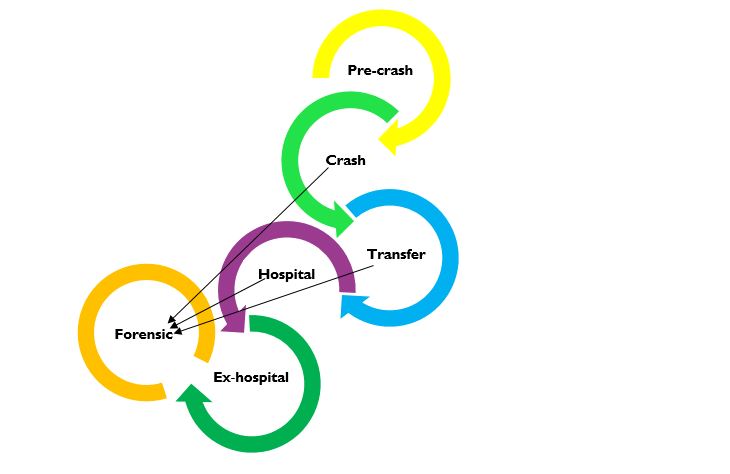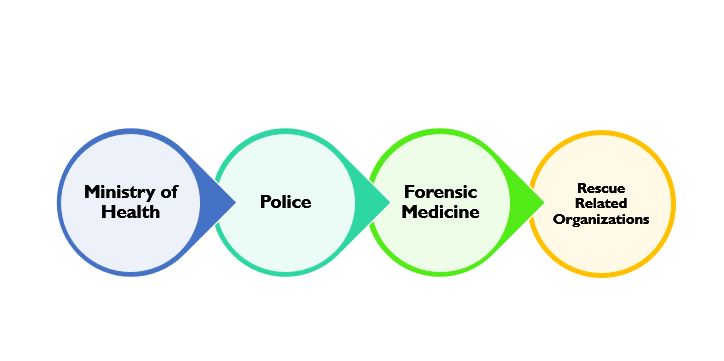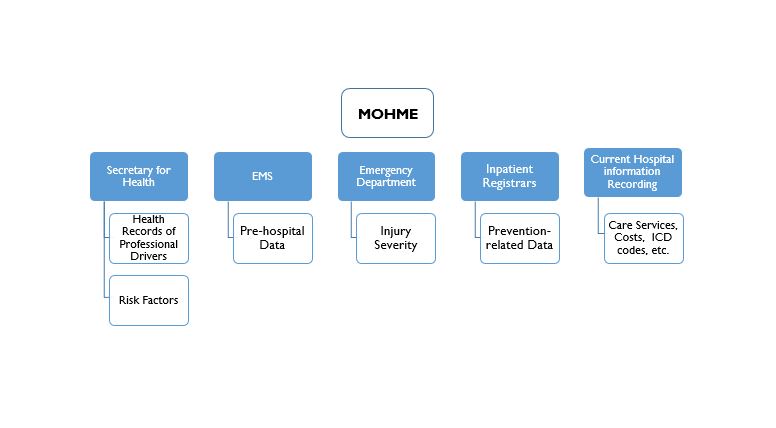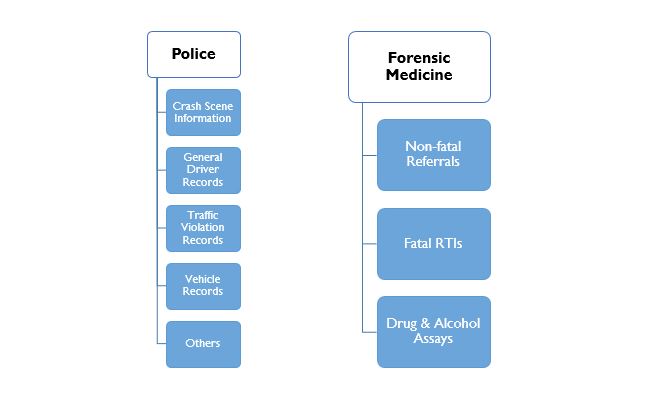National Integrated Road Traffic Injury Registry System
 Figure 1. The six components of the conceptual model for IRTIR
Figure 1. The six components of the conceptual model for IRTIR
Component 1: Aims and Core Definitions
Aims
The general aim of IRTIR was determined as “to register road traffic crashes leading to injuries or fatalities in Iran”. IRTIR was intended to register at least 95% of all severe road traffic injuries in Iran after full national implementation. It has been shown that under-reporting in road safety data decreases with the increase in accident severity and vice versa.
Core Definitions
Data collection can occur at different stations or by different organizations, but it should follow definitions and standards that will be provided in IRTIR protocol. The core definitions of IRTIR are described as follows:
- Road Traffic Crash: The following definition to include injury accidents was adopted from the glossary developed by the United Nations Economic Commission for Europe (UNECE) and the Organization for Economic Co-operation and Development (OECD) to be used for collection of data on transport in European Union country members. Any accident involving at least one road vehicle in motion on a public road or private road to which the public has right of access, resulting in at least one injured or killed person.
- Road Traffic Injury: “Fatal or non-fatal injuries incurred as a result of a road traffic crash”.
- Traffic Injury Fatality: A death occurring within 30 days of the road traffic crash and even beyond the given time period to ensure flexibility for future changes in definitions.
- Serious Traffic Injuries: Fractures, concussions, internal lesions, crushing, severe cuts and laceration, severe general shock requiring medical treatment and any other serious lesions entailing hospitalization. For practical reasons any traffic injuries leading to hospitalization for a period of more than 24 hours is also considered as serious injury.
Component 2: Content and Core Measurements
These core measurements (categories/subcategories) will later be used to define minimal dataset variables and a data dictionary. The main categories in this component were defined based on Haddon Matrix i.e. a well-known tool in road safety promotion and injury prevention.
Component 3: Data Flow
IRTIR will consider the collection of information starting from a crash station in two directions. First, this happens in the reverse direction extracting pre-crash data such as traffic violation records, and previous health records of the victims or those involved in a traffic crash as well as the traffic flow recorded for a short period before the crash. The latter is easily retrievable from the traffic flow database of the Ministry of Roads & Urban Development (MRUD) extracted from installed traffic cameras. Secondly and most importantly, the forward data collection will be done forming the main data flow pathway. A wide range of data could be collected at various stations such as crash scene, ambulance transfer, outpatient and inpatient care, post-discharge follow-up and forensic examinations (Figure 2).

Figure 2. Data flow diagram of the Integrated Road Traffic Injury Registry
Component 4: Data Collection Routines
Data Collection Tools
All the data collection tools should be either pre-validated available tools or tools specifically developed, adapted and validated for this registry.
Data Collection and Deposition Types
- Some data are collected using interviews and by completing paper questionnaires (such as nurse station data collection).
- Some data are collected and deposited using online forms and internet applications directly by the registrars (such as EMS data collection).
- Some data are extracted from currently available databases and added to the registry (Such as ICD10 data from a hospital information system).
- Some data are collected and directly deposited through automatic processes (such as data from traffic cameras).
- Other data types including GPS coordinates and crash scene photos.
Registrars
Various persons are involved in different stations of the IRTIR such as police officers, EMS staff, nurses, etc.
Component 5: Organizational Matrix
There are several RTI related organizations, which are data producers and/or data users (Figure 3).


 Figure 3. Various data produced by the three main traffic-related data production organizations in Iran
Figure 3. Various data produced by the three main traffic-related data production organizations in Iran
Component 6: IRTIR Implementation Organization
Such an organization in the IRTIR is comprised of a national steering board and several executive committees including Traffic Police, the MOHME, the Ministry of Roads & Urban Development (MRUD), Legal Medicine Organization, Judiciary Organization and rescue-related organizations such as the Red Crescent Organization and fire brigade departments. The national EMS organization will represent as the leading body on behalf of the MOHME, and the National Road Safety Commission will represent as the leading body on behalf of the MRUD.